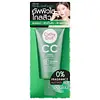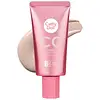What's inside
What's inside
 Key Ingredients
Key Ingredients

 Benefits
Benefits

 Concerns
Concerns

 Ingredients Side-by-side
Ingredients Side-by-side

Water
Skin ConditioningCyclopentasiloxane
EmollientGlycerin
HumectantPropylene Glycol
HumectantCaprylyl Methicone
Skin ConditioningTitanium Dioxide
Cosmetic ColorantCyclohexasiloxane
EmollientBetaine
HumectantCetyl PEG/PPG-10/1 Dimethicone
EmulsifyingMagnesium Sulfate
Dimethicone Crosspolymer
Emulsion StabilisingVp/Hexadecene Copolymer
Butylene Glycol
HumectantHydroxyacetophenone
Antioxidant1,2-Hexanediol
Skin ConditioningHydrolyzed Collagen
EmollientNiacinamide
SmoothingSodium Hyaluronate
HumectantRosa Rugosa Flower Oil
MaskingSalicylic Acid
MaskingHamamelis Virginiana Bark/Leaf Extract
AstringentBellis Perennis Flower Extract
Skin ConditioningCamellia Sinensis Leaf Extract
AntimicrobialCentella Asiatica Extract
CleansingCeramide AP
Skin ConditioningCeramide EOP
Skin ConditioningCeramide NP
Skin ConditioningChamomilla Recutita Flower Extract
MaskingGluconolactone
Skin ConditioningGlycyrrhiza Glabra Root Extract
BleachingPolygonum Cuspidatum Root Extract
AntioxidantRosmarinus Officinalis Leaf Extract
AntimicrobialScutellaria Baicalensis Root Extract
AstringentZinc PCA
HumectantCI 77492
Cosmetic ColorantCI 77491
Cosmetic ColorantCI 77499
Cosmetic ColorantWater, Cyclopentasiloxane, Glycerin, Propylene Glycol, Caprylyl Methicone, Titanium Dioxide, Cyclohexasiloxane, Betaine, Cetyl PEG/PPG-10/1 Dimethicone, Magnesium Sulfate, Dimethicone Crosspolymer, Vp/Hexadecene Copolymer, Butylene Glycol, Hydroxyacetophenone, 1,2-Hexanediol, Hydrolyzed Collagen, Niacinamide, Sodium Hyaluronate, Rosa Rugosa Flower Oil, Salicylic Acid, Hamamelis Virginiana Bark/Leaf Extract, Bellis Perennis Flower Extract, Camellia Sinensis Leaf Extract, Centella Asiatica Extract, Ceramide AP, Ceramide EOP, Ceramide NP, Chamomilla Recutita Flower Extract, Gluconolactone, Glycyrrhiza Glabra Root Extract, Polygonum Cuspidatum Root Extract, Rosmarinus Officinalis Leaf Extract, Scutellaria Baicalensis Root Extract, Zinc PCA, CI 77492, CI 77491, CI 77499
Water
Skin ConditioningCyclopentasiloxane
EmollientEthylhexyl Methoxycinnamate
UV AbsorberZinc Oxide
Cosmetic ColorantButylene Glycol
HumectantTitanium Dioxide
Cosmetic ColorantCetyl PEG/PPG-10/1 Dimethicone
EmulsifyingCaprylic/Capric Triglyceride
MaskingSorbitan Sesquioleate
EmulsifyingArbutin
AntioxidantDimethicone
EmollientTalc
AbrasiveSodium Chloride
MaskingBeeswax
Emulsion StabilisingPEG-10 Dimethicone/Vinyl Dimethicone Crosspolymer
StabilisingStearalkonium Hectorite
Gel FormingMagnesium Aluminum Silicate
AbsorbentDimethicone/Vinyl Dimethicone Crosspolymer
Skin ConditioningPhenoxyethanol
PreservativeOzokerite
Emulsion StabilisingRosmarinus Officinalis Extract
AntimicrobialBetaine
HumectantAloe Barbadensis Leaf Extract
EmollientChamomilla Recutita Flower Extract
MaskingDimethylmethoxy Chromanyl Palmitate
Skin ConditioningDipotassium Glycyrrhizate
HumectantPortulaca Oleracea Extract
Skin ConditioningSodium Hyaluronate
HumectantAdenosine
Skin ConditioningCI 77492
Cosmetic ColorantCI 77491
Cosmetic ColorantCI 77499
Cosmetic ColorantWater, Cyclopentasiloxane, Ethylhexyl Methoxycinnamate, Zinc Oxide, Butylene Glycol, Titanium Dioxide, Cetyl PEG/PPG-10/1 Dimethicone, Caprylic/Capric Triglyceride, Sorbitan Sesquioleate, Arbutin, Dimethicone, Talc, Sodium Chloride, Beeswax, PEG-10 Dimethicone/Vinyl Dimethicone Crosspolymer, Stearalkonium Hectorite, Magnesium Aluminum Silicate, Dimethicone/Vinyl Dimethicone Crosspolymer, Phenoxyethanol, Ozokerite, Rosmarinus Officinalis Extract, Betaine, Aloe Barbadensis Leaf Extract, Chamomilla Recutita Flower Extract, Dimethylmethoxy Chromanyl Palmitate, Dipotassium Glycyrrhizate, Portulaca Oleracea Extract, Sodium Hyaluronate, Adenosine, CI 77492, CI 77491, CI 77499
Ingredients Explained
These ingredients are found in both products.
Ingredients higher up in an ingredient list are typically present in a larger amount.
Betaine is a common humectant (a substance that promotes retention of moisture). It's known to be gentle on the skin and can help balance hydration.
This ingredient is best for improving hydration and soothing irritated skin. Studies also show it helps even out skin tone.
Fun fact: Betaine is naturally created in the skin and body. The kind found within cosmetic products can be either plant-derived or synthetic.
Another name for betaine is trimethylglycine.
Learn more about BetaineButylene Glycol (or BG) is used within cosmetic products for a few different reasons:
Overall, Butylene Glycol is a safe and well-rounded ingredient that works well with other ingredients.
Though this ingredient works well with most skin types, some people with sensitive skin may experience a reaction such as allergic rashes, closed comedones, or itchiness.
Learn more about Butylene GlycolThis ingredient is a high molecular weight silicone. It has emulsifying and skin conditioning properties.
Chamomilla Recutita Flower Extract comes from the Chamomile flower.
Chamomile is rich in antioxidants and has anti-inflammatory properties. Several compounds found in chamomile help with soothing, such as bisbolol.
Antioxidant components in chamomile make it an effective ingredient to help slow the signs of aging. Antioxidants help fight free-radical molecules, or molecules that may damage your skin.
Essential oils from chamomile have been found to improve wound healing due to its antimicrobial properties.
Ancient Greeks and Egyptians used Chamomile to treat skin redness and dryness. Chamomile has also been used to help treat stomach issues.
Learn more about Chamomilla Recutita Flower ExtractCi 77491 is also hydrated iron III oxide. It's sole purpose is to give a red/pink hue to products.
Iron III oxides are classified as inorganic chemicals for coloring.
Synthetically created Ci 77491 is considered safer than those naturally found. This is because the synthetically created version may contain less impurities. Iron oxides are generally non-toxic and non-allergenic.
Learn more about CI 77491Ci 77492 is also hydrated iron III oxide. It's sole purpose is to give a yellow hue to products.
Iron III oxides are classified as inorganic chemicals for coloring.
Synthetically created Ci 77492 is considered safer than those naturally found. This is because the synthetically created version may contain less impurities. Iron oxides are generally non-toxic and non-allergenic.
Learn more about CI 77492Ci 77499 is also hydrated iron III oxide. It is created from mixing red and black iron oxides. This helps give shades of darkness to a product.
Iron III oxides are classified as inorganic chemicals for coloring.
Cyclopentasiloxane, or D5, is a silicone used to improve texture of products and trap moisture.
D5 is considered lightweight and volatile. Volatile means it evaporates quickly after application. Once evaporated, D5 leaves a thin barrier that helps keep skin hydrated.
It is also an emollient. Emollients help soften the skin and prevent water loss. Silicones create a silky texture in products. D5 helps other ingredients become more spreadable.
Studies show D5 is safe to use in skincare products. We recommend speaking with a skincare professional if you have concerns.
Learn more about CyclopentasiloxaneSodium Hyaluronate is hyaluronic acid's salt form. It is commonly derived from the sodium salt of hyaluronic acid.
Like hyaluronic acid, it is great at holding water and acts as a humectant. This makes it a great skin hydrating ingredient.
Sodium Hyaluronate is naturally occurring in our bodies and is mostly found in eye fluid and joints.
These are some other common types of Hyaluronic Acid:
Learn more about Sodium HyaluronateTitanium dioxide is a mineral UV filter widely used in sunscreens and cosmetics.
It is one of only two UV filters officially classified as “mineral” by regulatory agencies, the other being zinc oxide.
Titanium dioxide provides broad-spectrum protection mostly in the UVB and UVAII range, with some protection in the UVAI range.
While its UVA protection isn’t as strong as zinc oxide’s, the difference is minor.
A common myth is that mineral UV filters reflect UV light. However, modern research shows titanium dioxide absorbs UV radiation like chemical filters (~95% absorption & 5% reflection).
Thanks to its non-irritating nature, titanium dioxide is suitable for sensitive, acne-prone, or redness-prone skin. It is unlikely to cause "eye sting" like other sunscreen ingredients.
A major drawback of this ingredient is its white cast and thick texture. This is why mineral sunscreens often leave a white cast and are less cosmetically elegant than chemical/hybrid sunscreens.
To improve white cast and spreadability, micronized or nano-sized titanium dioxide is often used.
There are ongoing concerns surrounding nano-titanium oxide's impact on marine ecosystems.
There is no conclusive evidence that any form of titanium oxide (or any other sunscreen ingredients) will cause harm to marine ecosystems or coral reefs. The science is still developing but many consumers are keeping a close eye on this issue.
Please note, many destinations have reef-safety sunscreen rules. For instance, the U.S. Virgin Islands advises all visitors to use non-nano mineral sunscreens.
Nano mineral sunscreens once raised safety concerns about absorption into skin.
Extensive research has shown that they do not penetrate healthy or damaged skin; they remain safely on the surface and the top layer of dead skin (stratum corneum).
You'll likely find titanium dioxide bundled with alumina, silica, or dimethicone. These ingredients help make titanium dioxide highly photostable; this prevents it from interacting with other formula components under UV light.
Learn more about Titanium DioxideWater. It's the most common cosmetic ingredient of all. You'll usually see it at the top of ingredient lists, meaning that it makes up the largest part of the product.
So why is it so popular? Water most often acts as a solvent - this means that it helps dissolve other ingredients into the formulation.
You'll also recognize water as that liquid we all need to stay alive. If you see this, drink a glass of water. Stay hydrated!
Learn more about Water